|
|
Butterflies - Skippers -
More Information
|
|
|
~ Click on any image for an enlargement - scrollable if it is too big for browser window ~
|
|
Kingdom: Animalia
Phylum: Arthropoda
Subphylum: Hexapoda
Class: Insecta Pterygota
Order: Lepidoptera
Family: Skippers Hesperiidae
Subfamilies: Grass Skippers Hesperiinae - Spread-wing Skippers Pyrginae
Family Description: The Hesperiidae are members of the Superfamily Hesperioidea. Worldwide in distribution, skippers are richest in the tropics. More than 3,500 species are described, with approximately 275 in North America, many of which are found only in Arizona and Texas. Most skippers are small to medium, usually orange, brown, black, white, or gray. A few have iridescent colors. Skippers have large eyes, short antennae (often with hooked clubs), stout bodies, and three pairs of walking legs. Their flight is often rapid, making wing movement appear blurred. Adults of most species have long probicscises and feed on floral nectar, but some also take up nutrients from bird droppings. Males have scent scales found in modified forewing patches. Males of most species locate mates by perching (grass and giant-skippers), though some patrol, especially in the open-winged skippers. Globular eggs are laid singly.
Subfamily Description: Grass skippers are members of the Family Hesperiidae. Distributed worldwide, they comprise more than 2,000 species, most of which are found in the American tropics. The small to medium-sized adults usually have abruptly angled antennae with an apiculus at the tip. Adults of many temperate species are predominantly orange, while brown is the most common color of the tropical species. Male forewings usually have a brand or stigma with specialized scales. Most species have long proboscises and are avid flower-visitors. Adults flight is rapid, and perching posture is unique: the hindwings are opened at a wider angle than the forewings. Males of most species perch while looking for mates. Caterpillars feed on monocotyledons (grasses and allied plants) and live in silken leaf nests that sometimes extend underground. Grass skippers typically overwinter as caterpillars within their shelters.
Subfamily Description: Spread-wing Skippers (Pyrgines) are primarily tropical American species of the Family Hesperiidae. There are approximately 80 North American species. Most genera are tropical, but the duskywings and checkered-skippers are mainly temperate and also occur in Eurasia. Adults of many species land with their wings open, although some perch with their wings closed or half open. They imbibe nectar from flowers, and males of many species take in moisture from moist sand or mud. Some adults also feed on bird droppings. Many tropical species rest underneath leaves when inactive. Females lay eggs singly. Most species lay eggs directly on host-plant leaves, while others lay on nearby plants or objects. Almost all species use broad-leafed plants as their caterpillar hosts, and caterpillars live in rolled-leaf or webbed-leaf shelters.
|
Clouded Skipper
Common/White Checkered-Skipper
Confused Cloudywing
Crossline Skipper
Dun Skipper |
Eufala Skipper
Firey Skipper
Funeral Duskywing
Horace's Duskywing
Juvenal's Duskywing
Lace-winged Roadside
Long-tailed Skipper |
Northern Broken-Dash Skipper
Northern Cloudywing
Silver-Spotted Skipper
Southern Broken-Dash Skipper
Tropical Checkered-Skipper
Twin-spot Skipper
Wild Indigo Duskywing
Yehl Skipper
Zarucco Duskywing |
Clouded Skipper Butterfly
Subfamily Hesperiinae
Lerema accius
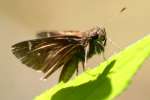 |
- Identification: Wings are dark brown. Upperside of male forewing has a dark black stigma; female forewing has transparent white spots. Underside of hindwing has dark and light patches and a violet-blue sheen.
- Life history: To seek females, males perch on vegetation a few inches from the ground in the partial shade of forest edges or clearings.
- Flight: Throughout the year in Florida and South Texas.
- Wing span: 1 1/4 - 1 3/4 inches (3.2 - 4.5 cm).
- Caterpillar hosts: Various grasses including St. Augustine grass (Stenotaphrum secundatum), wooly beard grass (Erianthus alopecturoides), and Echinochloa povietianum.
- Adult food: Various pink, purple, or white flowers including shepherd's needle, selfheal, vervain, buttonbush, and lantana.
- Habitat: Forest edges and clearings near rivers and swamps.
- Range: Georgia east to Texas; south to Florida; south through Mexico and Central America to Venezuela and Colombia.

|
Common/White Checkered-Skipper Butterfly
Subfamily Pyrginae
Pyrgus communis / Pyrgus albescens
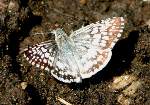 |
- Identification: Upperside of male is blue-gray; female is black. Both sexes have large white spots which form median bands across both wings. Fringes of male checkered but black checks often reach only halfway to edge of fringe. Male has a costal fold enclosing scent scales on the upperside of the forewing. Underside is dull white with dark gray or olive bands. Spots of the hindwing marginal row are very small; spots of the submarginal row are larger. This species is separated from the white checkered skipper with confidence only by dissection and examination of the male genitalia.
- Life history: Males patrol in swales most actively in the afternoon, and mating takes place then. Females lay eggs singly on leaf buds and tops of leaves. Adults roost exposed on a tall plant beginning in late afternoon. Caterpillars make folded-leaf nests in which they live and feed, and fully-grown caterpillars hibernate.
- Flight: February-October in the Deep South, March-September in the north.
- Wing span: 1 - 1 1/2 inches (2.5 - 3.8 cm).
- Caterpillar hosts: Several plants in the mallow family (Malvaceae) including globemallows (Sphaeralcea), mallow (Malva), hollyhock (Althaea), alkali mallows (Sida), velvet-leaf (Abutilon), and poppy mallow (Callirhoe).
- Adult food: Nectar from white-flowered composites including shepherd\'s needles, fleabane, and asters; also red clover, knapweed, beggar\'s ticks, and many others.
- Habitat: Open, sunny places with low vegetation and some bare soil including prairies, meadows, fields, roadsides, landfills, yards, gardens, pastures, openings and trails in woods.
- Range: Most of the temperate United States south to Gulf coast, w. Texas, se. Arizona, southern California, and mountains of northern Mexico. Colonizes as far north as central Alberta, southern Ontario, and southern New England. It cannot survive very cold winters and may not be a permanent resident north of the 40th parallel.

|
Common Sootywing Butterfly
Subfamily Pyrginae
Pholisora catullus
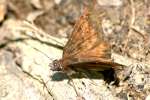 |
- Identification: Upperside is glossy black with small white spots on outer third of forewing. Female has more white spots on the forewing than the male, and a submarginal row of spots on the hindwing. Underside of forewing repeats the upperside; hindwing is solid black.
- Life history: Adults bask with the wings spread open. To find receptive females, males patrol near the ground in sunny places; mating takes place in the morning and afternoon. Near midday, females lay eggs singly on the tops of host plant leaves. Caterpillars live and feed within shelters of folded leaves. Caterpillars of the second brood overwinter in their silk-lined leaf shelters and pupate within them in the spring.
- Flight: Two broods; from May-August in the north, March-November in Texas.
- Wing span: 1 - 1 5/16 inches (2.5 - 3.3 cm).
- Caterpillar hosts: Lambsquarters (Chenopodium album), amaranths (Amaranthus), and cockscomb (Celosia).
- Adult food: Nectar from many flowers including dogbane, marjoram, oxalis, white clover, common milkweed, peppermint, cucumber, and melon.
- Habitat: Open or disturbed areas such as landfills, vacant lots, gardens, roadsides, fields, and pastures.
- Range: Central United States south to central Mexico. Strays and colonizes to southern British Columbia, northern Michigan, southern Quebec, and southern Maine. Does not occur in peninsular Florida.

|
Confused Cloudywing Butterfly
Subfamily Pyrginae
Thorybes confusis
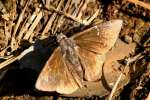 |
- Identification: Upperside is dark brown; forewing spots are transparent and elongated. Male lacks a costal fold. Underside of hindwing is dark brown with well-defined markings.
- Life history: Not reported.
- Flight: Two broods from April-August.
- Wing span: 1 1/2 - 1 7/8 inches (3.8 - 4.8 cm).
- Caterpillar hosts: Possibly bush clover (Lespedeza) in the pea family (Fabaceae).
- Adult food: Flower nectar.
- Habitat: Near swamps and marshes; woods in river valleys.
- Range: Southeastern Pennsylvania west to Missouri, south along the Atlantic Coastal plain to central Florida, the Gulf Coast, and Texas. Strays to southeastern Kansas, southern Illinois, and New Jersey.

|
Crossline Skipper Butterfly
Subfamily Hesperiinae
Polites origenes
 |
- Identification: Upperside is dark brown with orange markings. Female usually lacks orange along the forewing costa and has a square spot below the end of the cell; male has a long, straight forewing stigma. Underside of hindwing is orange-brown with a faint band of spots.
- Life history: Males perch in open grassy areas most of the day to await receptive females. Courtship occurs from midday to mid-afternoon. Third- and fourth-stage caterpillars hibernate.
- Flight: One brood from June-August in the north, two broods from May-September in the south.
- Wing span: 1 1/8 - 1 1/2 inches (2.9 - 3.8 cm).
- Caterpillar hosts: Purpletop (Tridens flavus), little bluestem (Andropogon scoparius), and other grasses.
- Adult food: White, pink, or purple flowers are preferred including purple vetch, red clover, selfheal, dogbane, shrub houstonia, New Jersey tea, and New York ironweed.
- Habitat: Open grassy areas including prairies hills, barrens, power line cuts, old fields, forest openings.
- Range: Western North Dakota east across central Minnesota, southern Ontario, and southern Quebec to central Maine; south to northeast Texas, the Gulf Coast, and northern Florida. A separate population (P. o. rhena) occurs along the Rocky Mountains from northern Colorado to northeastern New Mexico.

|
Dun Skipper Butterfly
Subfamily Hesperiinae
Euphyes vestris
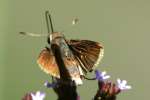 |
- Identification: Upperside of head and thorax is yellow-orange. Wings are brown-black; male forewing has a black stigma, female forewing has very small cloudy white spots.
- Life history: To find receptive females, males perch in low spots about 3 feet from the ground. Females lay eggs singly on leaves of the host plants. Caterpillars feed on leaves and make shelters of rolled or tied leaves. Third-stage caterpillars hibernate, emerge in the spring to complete their development, and pupate in silken tubes at the base of the plants.
- Flight: One brood from June-early August in the north; two broods from May-September in the mid-South; several broods from March-October in the Deep South and Texas.
- Wing span: 1 1/8 - 1 3/8 inches (2.9 - 3.5 cm).
- Caterpillar hosts: Various sedges including chufa flatsedge (Cyperus esculentus) and sun sedge (Carex heliophila).
- Adult food: Nectar from white, pink, or purple flowers including common milkweed, purple vetch, selfheal, peppermint, dogbane, New Jersey tea, and viper's bugloss.
- Habitat: Wet areas near deciduous woods such as meadows, seeps, swamp edges, and streams.
- Range: Nova Scotia west across southern Canada to southern Alberta; south to Florida, the Gulf Coast, and eastern Texas. Separate populations in the high plains and Rocky Mountains, and on the Pacific Coast.

|
Eufala Skipper Butterfly
Subfamily Hesperiinae
Lerodea eufala
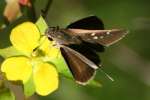 |
- Identification: Upperside is gray-brown; forewing has 3-5 small transparent spots; male has no stigma. Underside of hindwing is brown with heavy gray overscaling, only rarely with faint spots.
- Life history: Males perch in flat grassy areas on low vegetation to wait for receptive females. Eggs are laid singly on or near the host plants. Caterpillars eat leaves and make shelters of rolled or tied leaves.
- Flight: Two broods from February-October in the Deep South; several broods throughout the year in Florida, South Texas, and Arizona.
- Wing span: 1 - 1 1/4 inches (2.5 - 3.2 cm).
- Caterpillar hosts: Various grasses including Johnson grass (Sorghum halepense), Bermuda grass (Cynodon dactylon), and sugarcane (Saccharum officinarum).
- Adult food: Nectar from flowers including croton, alfalfa, composites, lippia, and others.
- Habitat: Open, sunny areas such as vacant lots, agricultural areas, road edges, and lawns.
- Range: Resident from coastal Georgia south through Florida and west across the southern United States to southern California; south through Mexico and Central America to Patagonia. Expands its range northward in the summer to central California, North Dakota, southern Wisconsin, northern Michigan, and Washington, D. C.

|
Firey Skipper Butterfly
Subfamily Hesperiinae
Hylephila pjyleus
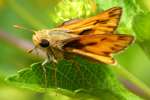 |
- Identification: Antennae are very short. Male wide black stigma. Underside of the hindwing is scattered with small black spots. Female: Upperside is dark brown with a very irregular orange band. Underside of hindwing is pale brown with paler checks.
- Life history: Males perch in lawns and grassy swales to wait for receptive females. Eggs are laid singly under leaves and also on other plants and objects. Caterpillars eat leaves and roll and tie them to make shelters which lie horizontally in the sod.
- Flight: Several broods from May-August in the north, all year in Florida and South Texas.
- Wing span: 1 1/4 - 1 1/2 inches (3.2 - 3.8 cm).
- Caterpillar hosts: Bermuda grass (Cynodon dactylon), crabgrass (Digitaria), St. Augustine grass (Stenotaphrum secundatum), and other grasses.
- Adult food: Nectar from flowers of a variety of plants including sweet pepperbush, swamp milkweed, asters, sneezeweed, knapweed, ironweed, and thistles.
- Habitat: Sunny, open areas such as fields, lawns, gardens, levees, roadsides, and second-growth scrub.
- Range: Southern United States south through the West Indies and Central America to Argentina. Cannot survive harsh winters; each summer this skipper may stray and re-colonize north to northern California, southern Minnesota, southern Ontario, and southern New England.

|
Funeral Duskywing Butterfly
Subfamily Pyrginae
Erynnis funeralis
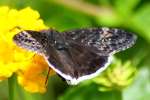 |
- Identification: Forewing is narrow and pointed, hindwing is somewhat triangular. Upperside of wing is black; forewing has a dull brown patch at the end of the cell. Hindwing has white fringe on the outer margin. Male has a costal fold containing yellow scent scales; female has a patch of scent scales on the 7th abdominal segment.
- Life history: Eggs are laid singly under host plant leaves. Caterpillars feed on leaves and rest in shelters of rolled or tied leaves. Caterpillars from the last brood hibernate.
- Flight: Three broods from March-December.
- Wing span: 1 5/16 - 1 3/4 inches (3.4 - 4.5 cm).
- Caterpillar hosts: Various legumes including New Mexican locust (Robinia neomexicana), bur clover (Medicago hispida), deerweed (Lotus scoparius), desert ironwood (Olneya tesota), and vetch (Vicia species).
- Adult food: Flower nectar.
- Habitat: Deserts, warm or arid lowlands, roadsides.
- Range: Southern California, Arizona, New Mexico, and Texas south to Argentina. Strays north to northern Illinois, northeast Nebraska, central Colorado, southern Nevada, and central California.

|
Horace's Duskywing Butterfly
Subfamily Pyrginae
Erynnis horatius
 |
- Identification: Fringes are brown. Upperside of male forewing is dark brown with little contrast and no white overscaling. Upperside of female forewing is light brown with a contrasting pattern and large transparent spots. Underside of hindwing is usually without 2 spots below the apex. Male has a costal fold containing yellow scent scales; female has a patch of scent scales on the 7th abdominal segment.
- Life history: To seek females, males perch at the ends of twigs on hilltops or slopes about 1 foot above the ground. Mating has been observed around midday; females deposit eggs singly on new growth of the host. Caterpillars feed on young leaves and rest in leaf nests. Caterpillars of the last brood hibernate.
- Flight: Two broods in the north from April-September, three broods in the Deep South and Texas from January-November.
- Wing span: 1 7/16 - 1 15/16 inches (3.6 - 4.9 cm).
- Caterpillar hosts: Both red and white oaks including willow oak (Quercus phellos), northern red oak (Q. velutina), scrub oak (Q. ilicifolia), water oak (Q. nigra), post oak (Q. stellata), and live oak (Q. virginiana).
- Adult food: Horace\'s Duskywing visits flower up to about 4.5 feet tall including dogbane, buttonbush, sneezeweed, goldenrod, peppermint, boneset, and winter cress.
- Habitat: Open woodlands and edges, clearings, fencerows, wooded swamps, power-line right-of-ways, open fields, roadsides.
- Range: Massachusetts west to eastern South Dakota; south through most of the eastern United States to Florida, the Gulf Coast, and South Texas; south in the west through southeastern Utah, Colorado, northeastern Arizona, and New Mexico.

|
Juvenal's Duskywing Butterfly
Subfamily Pyrginae
Erynnis juvenalis
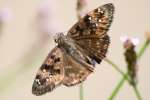 |
- Identification: Upperside of male is brown with clear spots, indistinct dark markings, and scattered white hairs; female has larger markings and spots. Underside of hindwing has 2 round pale spots below the apex. Male has a costal fold containing yellow scent scales; female has a patch of scent scales on the 7th abdominal segment.
- Life history: To wait for females, males perch in forest clearings or edges on bare twigs about 3-12 feet above the ground; they will often patrol from these perches. Females lay eggs singly on young leaves and seedlings of the host plants. Caterpillars feed on leaves and rest in nests of rolled or tied leaves; fully-grown caterpillars hibernate.
- Flight: One brood from April-June, emerging as early as late January in peninsular Florida.
- Wing span: 1 1/4 - 1 15/16 inches (3.2 - 4.9 cm).
- Caterpillar hosts: Tree and shrub oaks (Quercus species).
- Adult food: Nectar from flowers of winter cress, dandelion, wild plum, wisteria, blueberry, Carolina vetch, redbud, and lilac.
- Habitat: Oak woods or scrub and associated edges or fields.
- Range: Nova Scotia and central New England west through southern Manitoba to the Dakotas and northeastern Wyoming; south through most of the eastern United States to Florida, the Gulf states, and Texas. White-fringed populations occur in west Texas, New Mexico, and central Arizona south to central Mexico.

|
Lace-winged Roadside Skipper Butterfly
Subfamily Hesperiinae
Amblyscirtes aesculapius
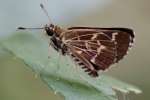 |
- Identification: Fringes are checkered black and white. Upperside of wings is dark brown; forewing has a row of white spots. Underside is dark brown with a yellow or white cobweb pattern.
- Life history: Not reported.
- Flight: Two broods from March-Septtember.
- Wing span: 1 3/16 - 1 1/2 inches (3-3.8 cm).
- Caterpillar hosts: Probably cane (Arundinaria).
- Adult food: Nectar from flowers including elephant\'s-foot, sweet pepperbush, blackberry, white clover, selfheal, and dogbane.
- Habitat: Moist, dense woods with cane growth.
- Range: Eastern Oklahoma and east Texas east to southeast Virginia, south along the Atlantic Coast to northern Florida.

|
Long-tailed Skipper Butterfly
Subfamily Pyrginae
Urbanus proteus
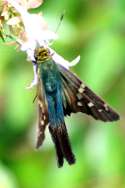
|
- Identification: Tails are long. Upperside is dark blackish brown; body and wing bases are iridescent blue-green. Males have a costal fold enclosing scent scales on the leading edge of the forewing. Dark row on underside of hindwing is a complete band.
- Life history: Adults roost upside down under leaves and limbs. To seek females, males perch 3-6 feet above the ground in sunlit openings. Females lay eggs under leaves in clusters of up to 20. Caterpillars feed on leaves and live in shelters of rolled leaves.
- Flight: Two to three broods throughout the year in south Florida and South Texas.
- Wing span: 1 3/4 - 2 5/16 inches (4.5 - 6 cm).
- Caterpillar hosts: Vine legumes including various beans (Phaseolus), hog peanuts (Amphicarpa bracteata), beggar's ticks (Desmodium), blue peas (Clitoria), and wisteria (Wisteria).
- Adult food: Flower nectar from a variety of plants including bougainvillea, lantana, and shepherd's needle.
- Habitat: Brushy fields, edges of woods, gardens, and other disturbed open habitats.
- Range: Argentina north through Central America, the West Indies, and Mexico to peninsular Florida and South Texas. Occasionally strays and colonizes north to Connecticut, southern Illinois, eastern Kansas, southern Arizona, and southern California.

|
Northern Broken-dash Skipper Butterfly
Subfamily Hesperiinae
Wallengrenia egeremet
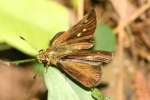 |
- Identification: Upperside is dark brown. Male forewing has a cream spot at the end of the cell, and a divided stigma (the "broken dash"); female forewing has a few elongated cream spots. Underside is dark brown or purple-brown; hindwing has a pale band of spots.
- Life history: Adults have a slow flight. Males perch up to 6 feet above ground to wait for females, usually in the early morning. Caterpillars eat leaves; half-grown caterpillars hibernate.
- Flight: One brood from June-August; two broods from May-October in the Deep South and east Texas.
- Wing span: 1 - 1 1/2 inches (2.5 - 3.9 cm).
- Caterpillar hosts: Panic grasses including deertongue grass (Panicum clandestinum) and P. dichotomum.
- Adult food: Nectar from white, pink, or purple flowers is favored including dogbane, red clover, New Jersey tea, and sweet pepperbush. Many other flowers are visited.
- Habitat: Open places near woods or scrub.
- Range: Southern Maine and southern Ontario west across the Great Lakes states to southeastern North Dakota; south to central Florida, the Gulf Coast, and southeast Texas.

|
Northern Cloudywing Butterfly
Subfamily Pyrginae
Thorybes pylades
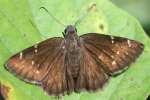
|
- Identification: Upperside is dark brown; clear spots on forewing are small, triangular, and not aligned. Male forewing has a costal fold enclosing scent scales. Underside is brown with gray overscaling; hindwing has 2 dark bands.
- Life history: Males perch on or near the ground in forest openings to wait for females. Eggs are laid singly under leaves of the host plants. Caterpillars feed on leaves and live in shelters of rolled or tied leaves. Fully-grown caterpillars hibernate.
- Flight: One brood from May-July in the north, earlier in the south. Two broods from March-September in Texas.
- Wing span: 1 1/4 - 1 7/8 inches (3.2 - 4.7 cm).
- Caterpillar hosts: Various plants in the pea family (Fabaceae) including beggar's ticks (Desmodium), bush clover (Lespedeza), clover (Trifolium), lotus (Hosackia), and others.
- Adult food: Usually nectar from blue, purple, pink, or white flowers including dogbane, selfheal, crown vetch, Japanese honeysuckle, thistles, common milkweed, Deptford pink, hoary vervain, and others.
- Habitat: Open or scrubby boreal woodland and forest edges.
- Range: Nova Scotia west across southern Canada to British Columbia, south through California and the Rocky Mountain states to Mexico, Texas, the Gulf states, and Florida.

|
Silver-Spotted Skipper Butterfly
Subfamily Pyrginae
Epargyreus clarus
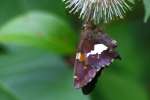 |
- Identification: Wings are brown-black; hindwing is lobed. Forewing has transparent gold spots; underside of hindwing has a metallic silver band.
- Life history: Adults perch upside down under leaves at night and on hot or cloudy days. To seek females males perch on branches and tall weeds, and occasionally patrol. Females lay single eggs near the host trees, and the caterpillars must find their proper host. Young caterpillars live in a folded leaf shelter; older ones live in a nest of silked-together leaves. Chrysalids hibernate.
- Flight: Two broods from May-September in most of the East, a single brood to the north and west, three-four broods from February-December in the Deep South.
- Wing span: 1 3/4 - 2 5/8 inches (4.5 - 6.7 cm).
- Caterpillar hosts: Many woody legumes including black locust (Robinia pseudacacia), honey locust (Gleditsia triacanthos) and false indigo (Amorpha species). Also selected herbaceous legumes such s Glycyrrhiza species.
- Adult food: The Silver-spotted Skipper almost never visits yellow flowers but favors blue, red, pink, purple, and sometimes white and cream-colored ones. These include everlasting pea, common milkweed, red clover, buttonbush, blazing star, and thistles.
- Habitat: Disturbed and open woods, foothill streamcourses, prairie waterways.
- Range: Extreme southern Canada and most of the continental United States except the Great Basin and west Texas; northern Mexico.

|
Southern Broken-Dash Skipper Butterfly
Subfamily Hesperiinae
Wallengrenia otho
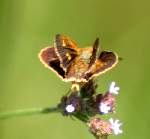 |
- Identification: Upperside of male is brown with a few orange or red-oranges patches and a two-part black stigma (the "broken dash"). Female upperside is dark brown with pale orange spots. Underside of hindwing in both sexes is orange or red-orange and has a band of pale spots.
- Life history: Males perch on vegetation within 2 feet of the ground to watch for females, usually in the early morning. Females lay eggs singly on or near the host plants. Caterpillars live in nests of silk-tied leaves; when they come out to eat they carry a piece of leaf over themselves for protection.
- Flight: Two broods (sometimes a partial third) from April-October; all year in peninsular Florida and South Texas.
- Wing span: 1 - 1 3/8 inches (2.4 - 3.5 cm).
- Caterpillar hosts: Paspalum and St. Augustine grass (Stenotaphrum secundatum).
- Adult food: Nectar from flowers including pickerelweed, selfheal, and sweet pepperbush.
- Habitat: Openings near wooded rivers or swamps.
- Range: Eastern Texas and the southeastern United States south through the West Indies and Central America to Argentina. Strays north to central Missouri, northern Kentucky, and Delaware.

|
Tropical Checkered-Skipper Butterfly
Subfamily Pyrginae
Pyrgus oileus
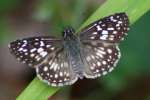 |
- Identification: Upperside is dark brown with pale markings; male forewing has a mat of long blue-gray hairs; hindwing of both sexes has marginal and submarginal bands made up of equal-sized spots. Underside of hindwing is pale, often with a strong brown overlay; not much contrast between bands and ground color.
- Life history: Males perch and patrol for receptive females. Eggs are laid singly on the uppersides of host plant leaves. Caterpillars feed and live in the shelter of a webbed leaf.
- Flight: Four to five broods throughout the year in South Texas and Florida.
- Wing span: 1 1/4 - 1 1/2 inches (3.2 - 3.8 cm).
- Caterpillar hosts: Several plants in the mallow family (Malvaceae) including axocatzin (Sida rhombifolia), mallow (Malva), hollyhock (Althaea rosea), velvet-leaf (Abutilon), and malva loca (Malvastrum).
- Adult food: Nectar from flowers of Sidas and small-flowered composites such as shepherd's needles.
- Habitat: Open, sunny areas including pastures, brushy fields, wooded trails, thorn-scrub, and roadsides.
- Range: Peninsular Florida, the Gulf Coast, and South Texas south through the West Indies, Mexico, and Central America to Argentina.

|
Twin-spot Skipper Butterfly
Subfamily Hesperiinae
Oligoria maculata
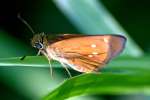
|
- Identification: Wings are rounded and brown-black. Upperside of forewing has 4 transparent spots. Underside of hindwing has a pale red-brown overlay and 3 oval white spots, 2 of which are close together.
- Life history: Not reported.
- Flight: Two broods from April-September, possibly three broods in Florida.
- Wing span: 1 3/8 - 1 5/8 inches (3.5 - 4.2 cm).
- Caterpillar hosts: Grasses.
- Adult food: Nectar including that from pickerelweed flowers.
- Habitat: Coastal swamps and pinewoods.
- Range: Coastal North Carolina south through Florida and west along the Gulf Coast to east Texas. A rare stray to Pennsylvania, Maryland, and New Jersey.

|
Wild Indigo Duskywing Skipper Butterfly
Subfamily Pyrginae
Erynnis baptisiae
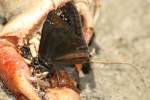 |
- Identification: Upperside of forewing is dark on the basal half and lighter on the outer half, with a distinct orange-brown patch at the end of the cell. Male has a costal fold containing yellow scent scales; female has a patch of scent scales on the 7th abdominal segment.
- Life history: Males perch in open areas on low shrubs to wait for females. Eggs are deposited singly on the host plant. Fully-grown caterpillars from the second brood hibernate.
- Flight: Two broods from late April to early June and from July to August.
- Wing span: 1 3/8 - 1 5/8 inches (3/5 - 4.1 cm).
- Caterpillar hosts: Usually wild indigo (Baptisia tinctoria), but also others including wild blue indigo (B. australis), lupine (Lupinus perennis), false lupine (Thermopsis villosa), and crown vetch (Coronilla varia).
- Adult food: Nectar from flowers of blackberry, white sweet clover, dogbane, sunflower, crimson clover, and probably others.
- Habitat: Open woods and barrens for native hosts. Highways, railroad beds, and upland fields for the introduced crown vetch.
- Range: Southern New England and southern Ontario west to central Nebraska; south to Georgia, the Gulf Coast, and southcentral Texas. The Wild Indigo duskywing is rapidly expanding its range and abundance by colonizing plantings of crown vetch along roadways and railroad beds. Comments: The Columbine, Wild Indigo, and Persius dusky wings belong to the "Persius complex," a confusing group of very similar butterflies.

|
Yehl Skipper Butterfly
Subfamily Hesperiinae
Poanes yehl
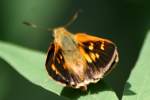 |
- Identification: Upperside is bright orange with wide dark borders; male forewing has a distinct linear stigma. Underside of hindwing is dark brown (female) or orange (males); both with 3-5 pale median spots.
- Life history: To await females, males perch about 3 feet above the ground on sunlit vegetation.
- Flight: Two broods from late May to mid-June and from mid-August to mid-November.
- Wing span: 1 5/16 - 1 3/4 inches (3.4 - 4.5 cm).
- Caterpillar hosts: Probably cane (Arundinaria species).
- Adult food: Nectar from flowers including sweet pepperbush, chinquapin, pickerelweed, and swamp milkweed.
- Habitat: Clearings in wet or swampy woodlands.
- Range: Southeast Virginia west to southwest Missouri; south to east Texas, the Gulf Coast, and northern Florida.

|
Zarucco Duskywing Butterfly
Subfamily Pyrginae
Erynnis zarucco
 |
- Identification: Forewing is narrow and pointed; hindwing is somewhat triangular. Upperside is dark brown with a reddish patch at the end of the forewing cell. Hindwing has brown fringes except for some individuals on the Florida Keys that have white fringes. Male has a costal fold containing yellow scent scales; female has a patch of scent scales on the 7th abdominal segment.
- Life history: Eggs are laid singly under host plant leaves. Caterpillars feed on leaves and rest in shelters of rolled or tied leaves. Caterpillars from the last brood hibernate.
- Flight: Three broods in the Deep South from March to early October, emerging as early as late January in Florida.
- Wing span: 1 5/8 - 1 7/8 inches (4.2 - 4.8 cm).
- Caterpillar hosts: Herbaceous legumes including black locust (Robinia pseudacacia), hairy bush clover (Lespedeza hirta), Colorado River hemp (Sesbania exaltata), and Sesbania longifolia.
- Adult food: Flower nectar including that from shepherd\'s needle.
- Habitat: Wood edges, open fields, scrub.
- Range: Southeastern United States from North Carolina south to the Florida Keys, west to eastern Texas and central Oklahoma. Strays north to eastern Pennsylvania and Connecticut. Occurs also on Cuba and Hispaniola.

|
| Information / Identification Sources: |
For identification our primary reference is Butterflies of North America - Kaufman Focus Guides - by Jim P. Brock & Ken Kaufman. We also use internet sources when in question - typically BugGuide and Jeff's Butterfly Page. Our text information (above) comes from Butterflies & Moths of North America. |
|


